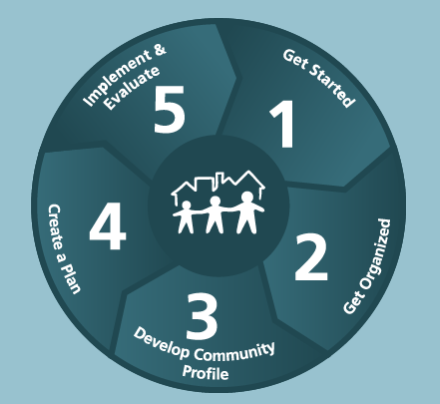
Communities That Care (CTC) is a community-based prevention system proven to reduce youth health and behavior problems community-wide. Most people want to help the young people in their community, but most do not know how. The CTC Framework focuses on utilizing evidence-based prevention programs and policies to guide a community through the model, offers tools to do so efficiently and effectively, and is proven to work.
Recently, Great Plains QIN had the opportunity to discuss the program with Corryn Gabbert, the South Dakota Department of Health community engagement coordinator. Gabbert helped us better understand the program and its impact on South Dakota communities.
Gabbert explained, “CTC programs are locally owned and operated. A local coalition makes decisions from its own data to address priority needs and underlying causes (risk and protective factors) of youth health and behavior problems. Communities get to choose the right programs and policies to address their biggest challenges.”
Seven South Dakota communities (Cheyenne River Reservation, Brown County, Hot Springs, White River, Wagner, Mitchell, and Sioux Falls Urban Indian Health) were previously funded. These communities have worked to address mental and physical health, school adherence, family relationships, substance abuse and suicide prevention among youth in their communities.
This evidence-based program utilizes a five-phase process that guides communities through developing a high-functioning community prevention coalition. Utilizing the Social Development Strategy, CTC fosters the success and health of young people through every stage of development by focusing on protective factors that increase the likelihood of health and success.
Phase 1: Communities get ready to introduce CTC
Community group explores key leader interest, attend orientation meetings, and recruit board members.
Phase 2: Communities form a board or work within an existing coalition
Community board is formed, and work begins to learn about prevention science, organize workgroups, and set a timeline for implementation of the CTC model.
Phase 3: Communities assess community risk and strengths and identify existing resources
Review data from youth survey, identify priority risk and protective factors, assess available resources, and identify gaps.
Phase 4: The community board creates a plan for prevention work in their community
Define clear, measurable outcomes using assessment data and select and expand programs for use in the community.
Phase 5: Implementation & Evaluation
Implement selected evidence-based programs and policies, monitor, measure results, and track progress toward community goals.
Gabbert emphasized the pivotal role the CTC coaches play. Currently, there are two CTC coaches in South Dakota who assist community leaders with training, facilitation, buy-in, technical assistance, and support throughout the program. These coaches are an integral part of assisting each community through the various phases and steps of the CTC Framework and serve as a continual point of connection for each community.
The Fall River County, SD Communities That Care coalition has worked tirelessly throughout their funding period with the South Dakota Department of Health to address several risk factors in their county. Their August 2023 Community Action Plan highlights their efforts in understanding the CTC process, program timeline, risk factor identification, resource assessment, programming to address the risk factors, and outcome goals. Alexander Nelson, Fall River County, SD CTC Board President and CTC Coalition Coordinator, has strengthened cross-sector partnerships within the county through his CTC work. Nelson shared that “Fall River, SD Communities That Care Coalition’s goal is to bring awareness and change to the issues affecting the youth of our communities and the adults they grow into.”
Gabbert concluded, “The number of community members who come together with a desire to tackle a challenge impacting the youth in their community is inspiring. These individuals are the committed ‘boots on the ground’ representing all walks of life. Their passion and sense of community are the driver for change, and we are seeing great results from their efforts.”
As health professionals explore ways to enhance community well-being, Communities That Care stands as a guide, powering communities towards collaborative, evidence-based approaches that bring about positive, sustainable change.
How to Get Started
The CTC process begins with a survey to identify a community’s risks and strengths. Based on the data, the CTC teams helps communities select and implement tested and effective prevention programs and policies. CTC also helps amplify programs already underway.
Requests for Applications for the next 2-year cycle of CTC coalitions is now available and will close on April 15 at 5 pm (CT). The application and supplemental documents can be found on the Good & Healthy SD website. Contact Corryn.Gabbert@state.sd.us for application information or with questions.
The Communities That Care (CTC) Program was developed in 2003 by the University of Washington as a way to prevent suicides through a science-based intervention strategy. Access the CTC site for more information, implementation tools and the science behind the success.

